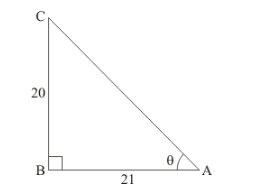If $\tan \theta=\frac{20}{21}$, show that $\frac{1-\sin \theta+\cos \theta}{1+\sin \theta+\cos \theta}=\frac{3}{7}$.
Given:
$\tan \theta=\frac{20}{21}$.....(1)
To show that:
$\frac{1-\sin \theta+\cos \theta}{1+\sin \theta+\cos \theta}=\frac{3}{7}$
Now we know $\tan \theta$ is defined as follows
$\tan \theta=\frac{\text { Perpendicular side opposite to } \angle \theta}{\text { Base side adjacent to } \angle \theta}$....(2)
Now by comparing equation (1) and (2)
We get
Perpendicular side opposite to $\angle \theta=20$
Base side adjacent to $\angle \theta=21$
Therefore triangle representing angle $\theta$ is as shown below

Side AC is unknown and can be found using Pythagoras theorem
Therefore,
$A C^{2}=A B^{2}+B C^{2}$Now by substituting the value of known sides from figure (a)
We get,
$A C^{2}=21^{2}+20^{2}$
$=441+400$
$=841$
Now by taking square root on both sides
We get,
$A C=\sqrt{841}$
$=29$
Therefore Hypotenuse side AC = 29 …… (3)
Now we know, $\sin \theta$ is defined as follows
$\sin \theta=\frac{\text { Perpendicular side opposite to } \angle \theta}{\text { Hypotenuse }}$
Therefore from figure (a) and equation (3)
We get,
$\sin \theta=\frac{B C}{A C}$
$=\frac{20}{29}$
$\sin \theta=\frac{20}{29} \ldots \ldots$(4)
Now we know, $\cos \theta$ is defined as follows
$\cos \theta=\frac{\text { Base side adjacent to } \angle \theta}{\text { Hypotenuse }}$
Therefore from figure (a) and equation (3)
We get,
$\cos \theta=\frac{A B}{A C}$
$=\frac{21}{29}$
$\cos \theta=\frac{21}{29}$....(5)
Now we need to find the value of expression $\frac{1-\sin \theta+\cos \theta}{1+\sin \theta+\cos \theta}$
Therefore by substituting the value of $\sin \theta$ and $\cos \theta$ from equation (4) and (5) respectively, we get,
$\frac{1-\sin \theta+\cos \theta}{1+\sin \theta+\cos \theta}=\frac{1-\frac{20}{29}+\frac{21}{29}}{1+\frac{20}{29}+\frac{21}{29}}$
Now by taking L.C.M on R.H.S of above equation
We get
$\frac{1-\sin \theta+\cos \theta}{1+\sin \theta+\cos \theta}=\frac{\frac{29-20+21}{29}}{\frac{29+20+21}{29}}$
$=\frac{\frac{29+1}{29}}{\frac{70}{29}}$
$=\frac{\frac{30}{29}}{\frac{70}{29}}$
$=\frac{30}{29} \times \frac{29}{70}$
$=\frac{30}{70}$
$=\frac{3 \times 10}{7 \times 10}$
Now as 10 is present in numerator as well as denominator of R.H.S of above equation, it gets cancelled and we get
$\frac{1-\sin \theta+\cos \theta}{1+\sin \theta+\cos \theta}=\frac{3}{7}$
Hence $\frac{1-\sin \theta+\cos \theta}{1+\sin \theta+\cos \theta}=\frac{3}{7}$
